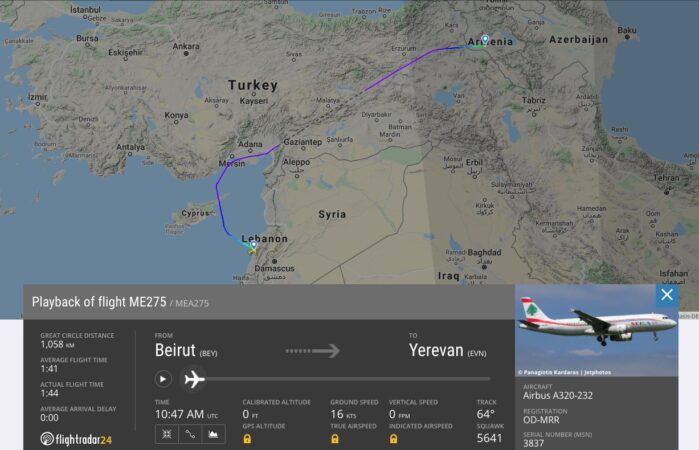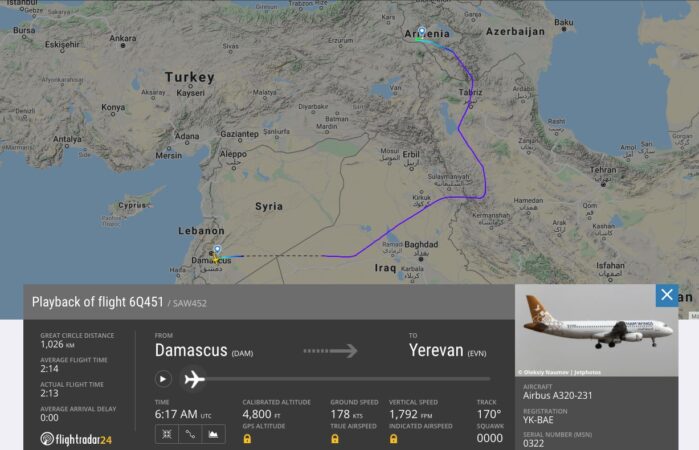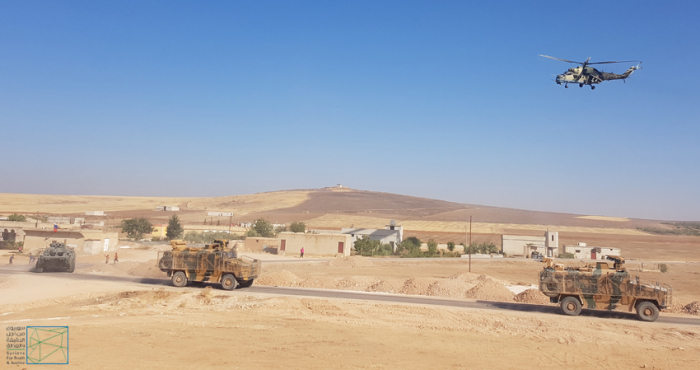From the Russia-operated Khmeimim Air Base, somewhere near Jableh city in Latakia province, Syrians were shipped off to fight as mercenaries alongside the Armenian forces in the war against Azerbaijan over September and October 2020, exactly as they were dispatched to Libya to lend the clashing parties there manpower earlier in the year. The Russian military carried out the enlistments in collusion with the Syrian government, according to the testimonies and accounts that Syrians for Truth and Justice (STJ) obtained from witnesses and several credible sources. The recruits are almost exclusively members of the 5th Legion and are particularly from the provinces of Homs and Deir ez-Zor.
The testimonies delivered by STJ’s field researchers verified that the said fighters/mercenaries were presumably bound for Libya. However, as fighting there showed signs of abating, the conflict over the Nagorno-Karabakh (also known as Artsakh) region flared up. The Russian forces thus shifted the destination, sending these fighters to Armenia instead of Libya, and hid the plan changes from nearly all the recruits.
At least five transfers of Syrian fighters/mercenaries are documented in this report, in addition to an estimation of casualties. STJ recorded nearly 10 deaths, with only a few bodies delivered to families so far, and over 40 wounded. The injured recruits were all returned from Armenia to Homs province and deposited at the military hospital there.
Furthermore, the report documents dozens of flights to Armenia through Beirut and Damascus airports of Syria-based Armenians. These flights, however, were not facilitated by the Russian military; they were rather organized by Armenian political parties in Lebanon and Syria and purely for military ends; money was not a driving force in these cases.
It ought to be mentioned that this report is one part of STJ’s larger efforts to investigate into the ongoing recruitment of thousands of Syrians, both militants and civilians, into warzones alien to them. These recruitments have so far been chiefly overseen by Turkey and Russia.
Methodology
For the purposes of this report, STJ conducted a total of 10 interviews with militants, including personnel of the Syrian government forces and fighters of an Armenian background, and civilians, including family members of recruits sent to Nagorno-Karabakh during the covered period. The persons whose testimonies are listed herein were contacted either in person or online throughout September, October and November 2020.
Besides, STJ’s digital forensics tracked the aircraft flights which transported fighters from Syria to Armenia, and analyzed the information from open-sources collected by the team.
1. Syrians Enlisted to Fight in Armenia as Mercenaries
A. How were these enlistments brokered?
The reported recruitments were arranged at the direct request of the Russian forces, stationed in Khmeimim Air Base, who summoned the Syrian government forces to their help. The latter played the mediator between clan dignitaries and brokers, registrars, closely affiliated to them on one hand, and the Russian forces on the other, according to the testimonies brought by STJ.
In Deir ez-Zor, military and civilian sources provided accounts indicating that clan notables and commanders of pro-government militias promoted such enlistments among Syrian men, grabbed the attention of some, and then commended them to the Russian forces. Among the brokers complicit in the recruitments were S. al-Harbi, M. al-Fayadd, M. al-Hamoud, and F. al-Iraqiya.
In Homs province, particularly the eastern suburbs, renowned figures also facilitated the recruitments, including F. al-Haddar, a sheikh of Bani Khalid clan, and M. al-Fadou’s, sheikh of al-Fawa’era clan, as well as M. al-Melehm and A. al-Nassif, who are leading figures of the al-Na’im clans.
Two batches of fighters/mercenaries were flown to Armenia on 21 October 2020, testified a recruit of the 5th Legion, founded by Russia and operating as part of the Syrian military. The first batch was brokered by M. al-Hamoud, including 23 recruits. The second batch was brokered by M. al-Fayadd, including 14 recruits. They were transported to Khmeimim Air Base, and shipped off to Armenia next.[2]
B. To Armenia instead of Libya
The enlistments of fighters to be mercenaries in Armenia were less straightforward than those meant for Libya, the witnesses interviewed by STJ’s field researchers accentuated. The recruits, or their families, were not provided any information as to the true destination. Many families were even shocked to hear that their sons are fighting in Armenia, while supposedly attending to certain tasks in Libya.
Commenting on this, a Capitan of the 5th Legion said:
“The recruits transferred to fight in Armenia weren’t entirely informed of the process’ details. They initially signed up to fight in Libya for money, given that drives advocating such enlistments were already underway across several provinces back in those months. I believe that the recruits were sent to Armenia as combat escalated there, while active fighting halted in Libya. It’s a good thing, I would rather say, because they were on the waiting lists.”
With respect to the so-called salaries the recruits are paid for fighting in Armenia, the Capitan added:
“Salaries often vary between 1000 and 2000 USD, depending on specialty and the skills demanded. The transferred recruits, however, are not entitled to compensation in cases of physical harm or injuries. We are also not obliged to search for missing recruits or conduct prisoner swap deals. Still, the recruits are free to receive the payments themselves, or delegate the matter to family members, who get paid by the brokers that signed up the recruits in the first place after deducting their own shares.”
One recruit’s mother, who was transferred to Armenia instead of Libya, said they were manipulated. Her son, J. S., was sent to Armenia without the slightest hint as to the destination. She recounted the following to STJ’s researcher:
“We were in a dire need for money, so my son sought S. al-Harbi’s office, intending to join his armed group—al-Harbi Brigade. There, they persuaded him into travelling to Libya, referring to a lucrative salary. He indeed registered his name, but was not signed up immediately. They called him on 15 September, saying a flight was heading to Libya soon. My son left home the next day. He called us from Khmeimim Air Base using an officer’s cellphone on 18 September, saying he was tasked with protecting vital facilities in Libya. That was the last time we heard from him. Later, people from al-Harbi’s office told us that my son and other young men were transferred to Armenia instead of Libya, claiming they were short on fighters there. We went to the office to inquire into his whereabouts, and there they told us he will return when his national duty is fulfilled. They assured us that he already received two months’ salary, and was still in Armenia.”
A relative of a recruit from Palmyra city, Homs province, said that M. A. was killed in action and his body was recently delivered to the family. M. A. signed up for Libya, but the target location changed, while neither he, nor his mates, knew of the alterations, the relative said, adding:
“In mid-August, M. A. registered his name to travel to Libya. The enlistment was brokered by A. Abdulmu’ti, a member of the National Defense Forces in Palmyra city. The registrar provided my relative with an advance of 500,000 Syrian pounds (SYP) on his 1000 USD salary. Other 15 men were also enlisted. They were all gathered at the Palmyra Air Base on 11 September, and spent the next two days there. From there, they were transferred to Khmeimim Air Base, and were eventually dispatched to Armenia. The recruits’ cellphones, watches, and other personal belongings, were all withheld before they travelled.”
C. Flights to Armenia
The Syrian mercenary fighters were flown from Khmeimim Air Base to Erebuni, in Armenia, aboard Russian military aircraft, a commander of the 5th Legion told STJ’s field researcher. The enlisted mercenaries were transferred on consecutive flights between 19 and 22 September. Others were transferred on 12, 21, and 27 October 2020.
STJ’s digital forensic attempted to track the aforesaid flights, but none of their logs were available on Flightradar24 website.
D. Deaths and injuries
Over September and October, the Russian forces transported the bodies of at least 15 Syrian mercenary fighters, who died in Armenia. Likewise, they transferred no less than 12 injured from Khmeimim Air Base to the Homs Military Hospital.
As many as six batches of dead or injured recruits arrived in the military hospital, coming from the Khmeimim Air Base, where they landed after being returned from Libya and Armenia in August, September, and October, a medical staffer of the Homs Military Hospital told STJ, stressing that the last two batches were undoubtedly brought back from Armenia. He said:
“Over the past three months, 35 bodies of fallen fighters and a larger number of wounded ones were deposited at the hospital, coming from Khmeimim Air Base. They were fighting in Libya, or Armenia/Azerbaijan. Many bodies have not yet been taken by families.”
He added:
“On 29 September, and 12 October, nine bodies were brought in, had fragmentation wounds all over the skin and displayed marks of gunshots. The dead were certainly transferred from Armenia, the injured assured us, not to mention the information we were provided by the officers who transported the bodies from Khmeimim Air Base to the hospital.”
In the same context, five bodies of Syrian mercenary fighters, killed in Armenia, were entered into Tartus Military Hospital in two batches on 12 and 27 October, a recruit of the 5th Legion told STJ’s researcher. They were then transported from the hospital to the Deir ez-Zor Airport. There, families were asked to come and receive their dead sons’ bodies.
There is information about an additional 14 wounded fighters, originally from Deir ez-Zor, who have not yet been transferred back from Armenia, the recruit added.
The parents of a mercenary fighter, recently killed in Armenia, were contacted by the 4th Division and asked to come and take their son’s body, along with his injured relative. The family said:
“The 4th Division broke the news. H. A. was only wounded. M. A. was killed. They said he died while performing national duty abroad. They told us that we could take the body and the injured young man from Homs Military Hospital. We indeed went there in the second half of October, and understood that both the killed and the injured recruits were transported from Khmeimim Air Base to the hospital aboard a military aircraft.”
2. Syrian-Armenians Join the Combat in Nagorno-Karabakh Independently
Based on accounts from five Syrian-Armenian sources, STJ documented that dozens of Armenians, based in Syria and other countries where they obtained asylum, have travelled to fight alongside the Armenian forces; independently and for non-monetary purposes. Travels as these were not arranged in coordination with any official entities in Syria, which were rather subject to arrangements between the persons in question and military entities in Armenia. Several of these individuals were killed while fighting.
One such Syrian/Armenian fighter narrated the following to STJ:
“Duty called. We travelled there to combat the aggression of Azerbaijan and Turkey, which threatened the Armenians’ existence. Those fighters came from Syria, Lebanon, South America, and even Canada. There were at least 147 of us. We were briefly trained on tackling arms at camps in the capital Yerevan. And then, we were grouped into divisions, each including 30 volunteer recruits.”
The fighter added:
“Right from the start of the war, Armenian volunteers were enlisting, particularly Lebanese and Syrians. Those based in Bourj Hammoud town, Lebanon, registered their names with the Armenian Secret Army for the Liberation of Armenia (ASALA). Others, recruits of the allied forces found by Russia in al-Hasakah province, volunteered under the command of Rizjan Saranjian, a veteran of the Nagorno-Karabakh conflict.”
Two batches of fighters travelled from Syria and Lebanon to participate in the combat in Armenia, the spokesperson of Armenian Christians in Kesab in Latakia province, Garo Manjikian, told STJ. He added:
“The first batch travelled through Beirut Airport on 6 October 2020. The second batch, however, left through the Damascus International Airport, flown by the Cham Wings Airlines on 17 October 2020. The second group included Armenian volunteers, and others who are members of the Iranian Quds Force.”[3]
He added:
“The population of the Armenian villages in Kesab, Latakia province, almost entirely resettled in Lebanon. When the dispute over Nagorno-Karabakh broke out, a member of the Lebanese Free Patriotic Movement, T. A., played an essential role in organizing Armenian young men, both Syrians and Lebanese, and sending them to the battlefield there. The Armenian Revolutionary Federation (also known as Dashnaktsutyun), the largest Armenian political party in Lebanon, sent some of its recruits to fight there as well.”
An estimated 200 Syrian-Armenian young men are today present in Armenia for combat-related purposes, the source stated. Most of these headed there to fight and to get the Armenian nationality later on.
Tracking the information provided by the above-cited source, STJ’s digital forensic spotted the two flights below.

Image 1: Screenshot taken from Flightradar24 website in the evening and at dawn, respectively on 5 and 6 October 2020. It demonstrates the details of the flight reported by the above-cited source.

Image 2: Screenshot taken from Flightradar24 website on 17 October 2020. It demonstrates the details of the flight reported by the above-cited source.
STJ also interviewed Rafi Ghazarian, who stated:
“Some Armenians travelled from Syria and Lebanon to fight in Armenia. There were also campaigns to collect donations and assistance from Armenian residents in both countries to send them there, particularly to Syrian Armenians who sought refuge in Nagorno-Karabakh, escaping the war in Syria. As Armenians, we will not allow a repetition of the 1915 massacre.”
For his part, Hagop Pakradounian, a leader of the Armenian Revolutionary Federation (ARF), told STJ’s field researcher that the federation maintains no relations with the Armenian fighters, who left Syria and Lebanon for Armenia. The federation neither coordinated with fighters, nor arranged, their transfer, he said, adding that:
“All the fighters in question have been travelling individually and of their own accord. After all, we cannot prevent anyone from performing their duties.”
Investigating into the reported deaths among fighters in Armenia, STJ interviewed an Aleppo-based Syrian-Armenian young woman, who said that several Armenian young men from the city travelled to Armenia after they registered their names with the Lebanese ARF. She added:
“We were informed that three died in Shushi province, Nagorno-Karabakh—Harut Banuyan, a resident of the Sulaimaniyah neighborhood, Musik Siklimian, a resident of the al-Azizieh neighborhood, and Hakob Stragian, a resident al-Slaibeh al-Jdeideh neighborhood. All three were returned and buried in Syria. We were also told that 18 other Armenians from Aleppo city were wounded.”
Read the original article on stj-sy.org.
Disclaimer: The information contained in this article does not necessarily reflect the official policy or position of AzVision.az news portal.
More about:
















































